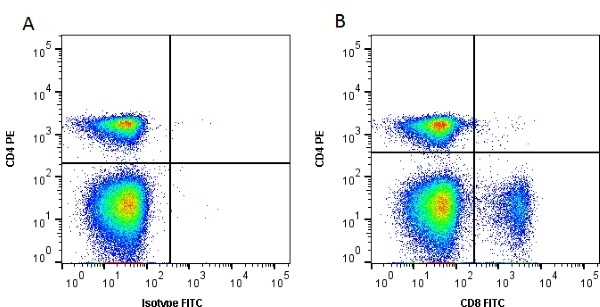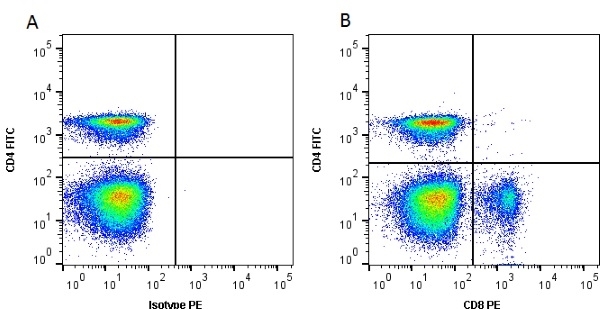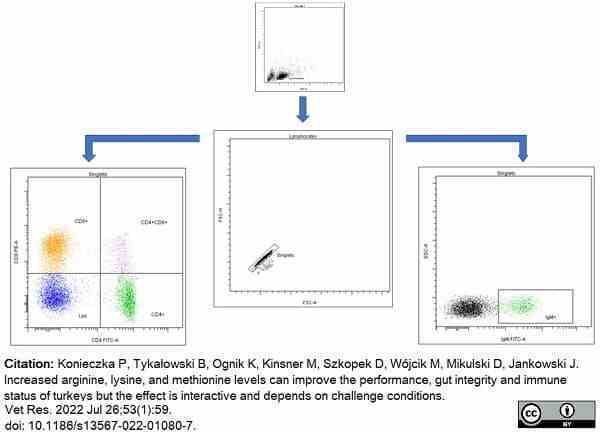CD8 Alpha antibody | 11-39



Mouse anti Chicken CD8 Alpha:FITC
- Product Type
- Monoclonal Antibody
- Clone
- 11-39
- Isotype
- IgG1
- Specificity
- CD8 Alpha
| Mouse anti chicken CD8 alpha, clone 11-39 recognizes the alpha chain of the chicken CD8 homologue, a 33-35 kDa cell surface protein. CD8 is expressed as either alpha/alpha homodimers or alpha/beta heterodimers on a subpopulation of T cells and NK cells. Mouse anti chicken CD8 alpha, clone 11-39 recognizes all polymorphic forms of chicken CD8 alpha. Mouse anti chicken CD8 alpha, clone 11-39 has been demonstrated to cross react with Turkey (Li et al. 1999). |
- Target Species
- Chicken
- Species Cross-Reactivity
-
Target Species Cross Reactivity Turkey - N.B. Antibody reactivity and working conditions may vary between species.
- Product Form
- Purified IgG - liquid
- Preparation
- Purified IgG prepared by affinity chromatography on Protein A from tissue culture supernatant
- Buffer Solution
- Phosphate buffered saline
- Preservative Stabilisers
- 0.09% sodium azide (NaN3)
1% bovine serum albumin - Immunogen
- Chicken T-cells.
- Approx. Protein Concentrations
- IgG concentration 0.1 mg/ml
- Fusion Partners
- Lymph node cells from immunised Balb/c mice were fused with cells of the SP2/0 myeloma cell line.
- Max Ex/Em
-
Fluorophore Excitation Max (nm) Emission Max (nm) FITC 490 525 - Regulatory
- For research purposes only
- Guarantee
- 12 months from date of despatch
Avoid repeated freezing and thawing as this may denature the antibody. Storage in frost-free freezers is not recommended.
| Application Name | Verified | Min Dilution | Max Dilution |
|---|---|---|---|
| Flow Cytometry | Neat | 1/5 |
- Flow Cytometry
- Use 10μl of the suggested working dilution to label 106 cells in 100μl
| Description | Product Code | Applications | Pack Size | List Price | Your Price | Quantity | |
|---|---|---|---|---|---|---|---|
| Mouse IgG1 Negative Control:FITC | MCA928F | F | 100 Tests |
|
Log in | ||
| List Price | Your Price | ||||||
|
|
Log in | ||||||
| Description | Mouse IgG1 Negative Control:FITC | ||||||
References for CD8 Alpha antibody
-
Luhtala, M. et al. (1995) Characterization of chicken CD8-specific monoclonal antibodies recognizing novel epitopes.
Scand J Immunol. 42 (1): 171-4. -
Luhtala, M. et al. (1997) Polymorphism of chicken CD8-alpha, but not CD8-beta.
Immunogenetics. 46 (5): 396-401. -
Li, Z. et al. (1999) Cross-reactive anti-chicken CD4 and CD8 monoclonal antibodies suggest polymorphism of the turkey CD8alpha molecule.
Poult Sci. 78 (11): 1526-31. -
McKenna, G.F. (2003) Immunopathologic investigations with an attenuated chicken anemia virus in day-old chickens.
Avian Dis. 47: 1339-45. -
Morimura, T. et al. (1996) Apoptosis and CD8-down-regulation in the thymus of chickens infected with Marek's disease virus.
Arch Virol. 141 (11): 2243-9. -
Luhtala M (1998) Chicken CD4, CD8alphabeta, and CD8alphaalpha T cell co-receptor molecules.
Poult Sci. 77 (12): 1858-73. -
Imhof, B.A. et al. (2000) Intestinal CD8 alpha alpha and CD8 alpha beta intraepithelial lymphocytes are thymus derived and exhibit subtle differences in TCR beta repertoires.
J Immunol. 165 (12): 6716-22. -
Arstila, T.P. & Lassila, O. (1993) Androgen-induced expression of the peripheral blood gamma delta T cell population in the chicken.
J Immunol. 151 (12): 6627-33.
View The Latest Product References
-
Bohls, R.L. et al. (2006) The use of flow cytometry to discriminate avian lymphocytes from contaminating thrombocytes.
Dev Comp Immunol. 30 (9): 843-50. -
Powell, F.L. et al. (2009) The turkey, compared to the chicken, fails to mount an effective early immune response to Histomonas meleagridis in the gut.
Parasite Immunol. 31 (6): 312-27. -
Katevuo, K. & Vainio, O. (1996) Thymocyte emigration in the chicken: an over-representation of CD4+ cells over CD8+ in the periphery.
Immunology. 89 (3): 419-23. -
Morimura, T. et al. (1995) Immunomodulation of peripheral T cells in chickens infected with Marek's disease virus: involvement in immunosuppression.
J Gen Virol. 76 ( Pt 12): 2979-85. -
Powell, F. et al. (2009) Development of reagents to study the turkey's immune response: Identification and molecular cloning of turkey CD4, CD8α and CD28.
Dev Comp Immunol. 33 (4): 540-6. -
Juul-Madsen, H.R. et al. (2002) Major histocompatibility complex-linked immune response of young chickens vaccinated with an attenuated live infectious bursal disease virus vaccine followed by an infection.
Poult Sci. 81 (5): 649-56. -
Wang, Y. et al. (2003) A novel method to analyze viral antigen-specific cytolytic activity in the chicken utilizing flow cytometry.
Vet Immunol Immunopathol. 95 (1-2): 1-9. -
Arstila, T.P. et al. (1995) Primed avian γδ T cells respond to mycobacterial antigens, but show no preference for the 65-kDa heat shock protein.
Cell Immunol. 162 (1): 74-9. -
Arstila, T.P. et al. (1994) γδ and αβ T cells are equally susceptible to apoptosis.
Scand J Immunol. 40 (2): 209-15. -
Rosa, A.C. et al. (2014) Isolation and molecular characterization of Brazilian turkey reovirus from immunosuppressed young poults.
Arch Virol. 159 (6): 1453-7. -
Röhe I. et al. (2017) Effect of feeding soybean meal and differently processed peas on the gut mucosal immune system of broilers.
Poult Sci. 96 (7): 2064-73. -
Kannan, T.A. et al. (2017) Age Related Changes in T Cell Subsets in Thymus and Spleen of Layer Chicken (Gallus domesticus)
Int J Curr Microbiol App Sci. 6 (1): 15-9. -
Konieczka, P. et al. (2022) Increased arginine, lysine, and methionine levels can improve the performance, gut integrity and immune status of turkeys but the effect is interactive and depends on challenge conditions.
Vet Res. 53 (1): 59.
- RRID
- AB_2075649
MCA2166F
If you cannot find the batch/lot you are looking for please contact our technical support team for assistance.
Please Note: All Products are "FOR RESEARCH PURPOSES ONLY"
View all Anti-Chicken ProductsAlways be the first to know.
When we launch new products and resources to help you achieve more in the lab.
Yes, sign me up

